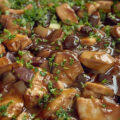On our Russian New Year’s table, there was always bread with ikra (red salmon caviar), ground up beef liver paté (pashtet), and a big tray of holodets. Suspended in a meat geleé, this quivering mass held layers of meat, sliced eggs and occasionally, a carrot slice or two. It was topped with a few dill or parsley leaves, and eaten with strong mustard. While the rest of the food on the table gradually depleted as the evening progressed, this culinary dinosaur sat there, like the Grande Dame of meat jello, untouched and unruffled.
As part of the Soviet Union’s dedication to frugality and nose-to-tail eating, Russian and Ukrainian Jews embraced holodets. Yet they seemed to forget that this ancient dish predates the Soviet Union’s culinary project by a few centuries, and has a resoundingly Jewish history.
Known in Yiddish as ptcha, the dish the French call aspic actually originates in Turkish cuisine in the 14th century. It made its way to Eastern Europe around the 18th century and was embraced by Ashkenazi Jews as a way to convert cheap meat cuts and bones into a dish worthy of a celebration.
To me, holodets was that weird thing no one ate. But to my ancestors, Ptcha was a way to transform even the smallest part of the animal into a festive serving, to turn the mundane into the extraordinary. It spoke of resourcefulness, a hopeful spirit and tenacity that I’ve long come to associate with Jewish traditions.
When I learned the history of this dish, I immediately approached my paternal grandmother for her recipe of holodets - the same one no one wanted to eat for years.
“What? I never made that,” she argued adamantly.
After a long conversation, we finally settled that it was her late sister Sonia who used to make the holodets for our family celebrations. She learned it from her mother, my great-grandmother Esther. But as Sonia passed away 5 years ago, taking with her a treasure trove of Jewish recipes, there was no one of whom we could ask of this family recipe.
And so, the hunt was on. What proceeded next was worthy of a scene in a Hollywood movie (a sequel to the Bucket List, perhaps), or at least a Mordechai Richler novel. Within half an hour, my grandmother had telephoned four of her friends, and visited three others who lived down the hall.
Few of these elderly Russian-speaking Jewish women bothered to make ptcha anymore - there was simply no one left to eat it. But they were thrilled to be asked to share their family recipes of this Jewish classic.
Just like that, we had a recipe for Ptcha. Cobbled together like a creature of Dr. Frankenstein, this recipe came from word of mouth. It arose from scribbled recipes on yellowing pages scribbled by shaking hands, pockmarked by age. And it was supplemented by good old Internet research, and consultation of Russian cookbooks.
This ptcha recipe is as authentic as it gets. It may not look very appealing, nor is it easy to make, but its taste brings back old forgotten flavors. Eaten on dark rye bread with a schmear of strong Russian mustard, it even tastes good. And maybe, for one short minute, it can help raise the dead - or at least, bring up their memory.
Ingredients
- 2 turkey necks
- 2 turkey breasts
- 2-3 chicken quarters bone-in and skin-on
- 2 cups chicken or beef bones
- 2-3 cow's or lamb’s feet
- 1 whole onion skin on
- 2 tablespoons whole black peppercorns optional
- 2 bay leaves optional
- 6-10 eggs
- 1 carrot peeled, optional
- Parsley or dill for topping
Nutritional Facts
Instructions
- Place all the bones and meat products in a large pot, and cover with water. Bring to a boil, then lower to minimum heat and cook for 6-8 hours. You can add a few peppercorns and bay leaves in the last hour. Remove the onion at the same time.
- While the stock is cooking, add eggs to a small saucepan, and fill with water. Bring to a boil, turn off and let eggs sit in water for 13 minutes. Remove eggs from water and transfer to a cold water bath to cool completely. Peel eggs, and set aside.
- OPTIONAL: In the same water, cook a carrot until it can easily be pierced with a fork. Cool completely. Slice into rings, and set aside.
- Once stock is done cooking, remove it from heat. Let it cool completely. The meat and skin should be falling off the bone at this point.
- Run the stock through a fine mesh sieve. Discard the bones, the cartilage and the fat. Set stock aside.
- Remove the meat onto a cutting board, taking care to discard any remaining bone pieces. You should be left with only the best meat. Shred finely with two works, large cleaver or two knives until you end up with small pieces. Mix all the meat and set aside.
- Select a transparent dish in which to serve the ptcha. You can use a large casserole dish, or several small dishes.
- Through a fine mesh sieve, pour in a thin layer of the broth into the serving dish. Add boiled egg slices and carrot slices, if using. You can create a design.
- Top the eggs and carrot slices with another thin layer of cooking liquid. Top generously with the meat - it should comprise the bulk of the dish - and more of the broth until the dish is full.
- Transfer ptcha to the fridge to cool. If a layer of white fat results at the top, remove it gingerly with a butter knife.
- To serve, top the dish with a large platter. Invert the ptcha. Top with fresh herbs before serving cold, with strong mustard, horseradish and bread.


















